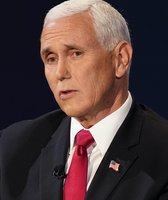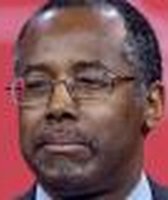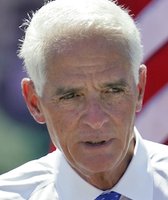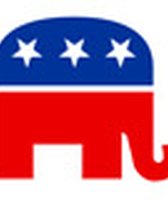Stand up for the facts!
Our only agenda is to publish the truth so you can be an informed participant in democracy.
We need your help.
I would like to contribute
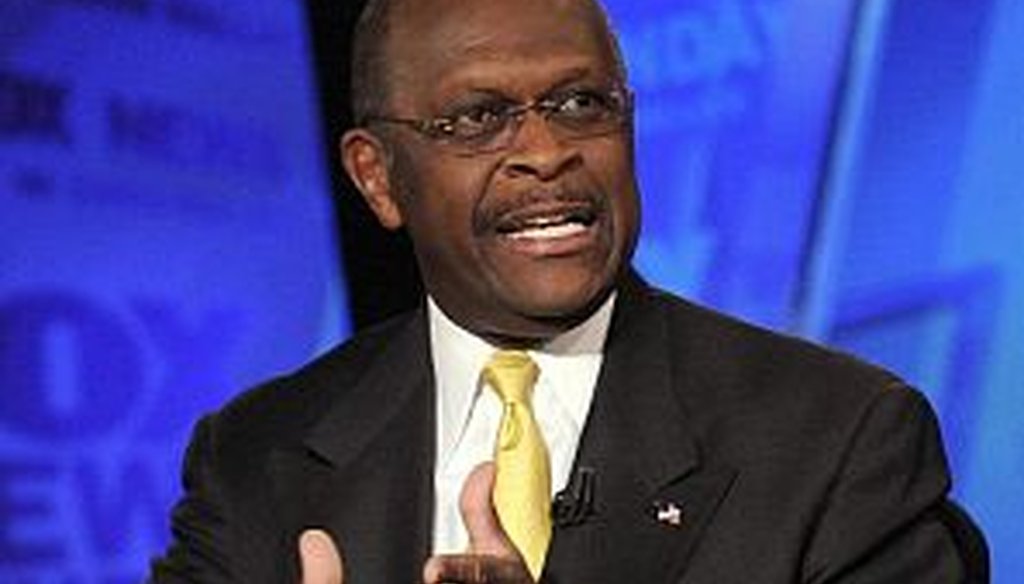
Herman Cain discusses his candidacy for president on Fox News.
The Republican field for president includes the usual mix, professional politicians who have been governors, senator, or speaker of the House. Herman Cain stands out not only because he hasn’t held elective office, but because he used to sell pizza.
His experience in business has attracted early interest from Republican voters, especially the tea party movement. Last month, a Fox News focus group said overwhelmingly that Cain won the first GOP debate.
Pizza is Cain's biggest selling point. He says his track record running Godfather’s Pizza, a chain that once billed itself as "the cure for the pizza emergency," shows he has the ability to run the country. The 620-store chain was on the brink of bankruptcy when he arrived in 1986, he says, and he "turned it around with common-sense business principles."
A PolitiFact examination of Godfather’s, based on interviews with industry analysts and company officials, shows Cain is largely correct. The chain wasn’t literally preparing paperwork for bankruptcy, but it was widely considered troubled. Cain changed that by uniting the franchisees, overhauling the chain's advertising, and getting his team focused on its core mission: pizza.
Burgers before pizza
Cain grew up in Atlanta, the son of a chauffeur to a Coca-Cola executive. He majored in math at Morehouse College and got a master’s degree in computer science from Purdue University. He started his early career as a technology manager before eventually joining Pillsbury and entering a fast-track program for young executives.
His first big challenge in the restaurant business was turning around the Burger King stores in Philadelphia, which at the time were low performers. Cain went through "burger boot camp," putting burgers on the broiler himself and learning the restaurants' operations from the ground up. He went on the road, visiting other franchises in the region and getting other managers to improve operations. Colleagues remember him as a sharp manager and an inspirational leader with a knack for getting people to work together.
Spencer Wiggins was a human resources officer working at Kraft Foods when an executive headhunter recruited him for Cain’s Burger King project. Wiggins said he wasn’t interested in working in restaurants, but the head hunter talked him into meeting Cain.
When Wiggins walked into the room, Cain pulled out a folder, looked him right in the eye, and said, "Spencer Wiggins! My man! I have been waiting for you!"
"It was like he had known me all my life," Wiggins recalled from his home in Nashville. "And the next thing I knew I was working for the Burger King corporation."
In 1986, Pillsbury tapped Cain to rescue Godfather’s, an Omaha-based subsidiary it had just acquired, and the story virtually repeated itself. Cain asked Wiggins to go with him.
"I said ‘Herman. C’mon, man. Omaha, Nebraska?’ I just don’t have it on my map to go to Omaha. Herman said, just come out and look around. And at the end of the day, I ended up moving to Omaha."
The Godfather’s story
Pillsbury bought Godfather’s largely by accident, according to press reports from the time. Godfather’s was part of Diversifoods Inc., a conglomerate that included more than 300 Burger King franchises. Pillsbury wanted the Burger Kings, and the chain of more than 800 Godfather’s pizza restaurants came with it.
"The value of Diversifoods was its ownership of the Burger Kings, and the deal made sense without Godfather's," John McMillin, an industry analyst, told the Chicago Tribune shortly after the deal. "Pillsbury got Godfather's for nothing, and some said they got what they paid for."
The chain’s problems included franchisee lawsuits, an overly long menu, and a dejected workforce. Even its TV ads seemed hapless, showing a car full of executives driving around, unable to find a Godfather's. ("Find one. It's worth it," the ad lamely concluded.) As Cain said later, the chain had "had one foot in the grave and the other on a banana peel."
Cain attacked problems on every front. He declared the company’s advertising account up for review, pitting ad agencies against each other in a bidding war. He trimmed the menu and enforced quality standards. He pushed more restaurants to offer delivery, and he closed low-performing franchises.
He emphasized communication, giving speeches at important moments to employees and franchisees. After his first 60 days at Godfather's, he gave a speech he called "get on the wagon," which he now uses in political speeches.
When he was a boy, Cain said, his grandfather, a potato farmer, would hitch up his mules for the weekly trip to town. Any grandchildren who wanted to go could ride along. Cain would finish the story in his grandfather’s thundering voice: "Them that’s going, get on the wagon! Them that ain’t, get out of the way!"
Charles Henderson, who runs coffee kiosks in Pennsylvania, was Cain’s director of marketing back then. He says Cain is "probably the most inspirational person I’ve ever met in my life."
"He can be mesmerizing. He’s very dynamic. I’m not slamming our current president, but Herman Cain will give a 20- or 30-minute speech extemporaneously, and certainly without teleprompters. He is without a doubt the most dynamic speaker I’ve ever heard," Henderson said.
Henderson said Cain succeeded because he immersed himself in all aspects of the business and wasn’t afraid to get his hands into the dough. Cain baked pies on a weekly basis after he arrived in Omaha. "He loved to make pizzas. We had a test store over on Pacific Street, which wasn’t too far from Godfather’s, and once a week, he’d round us all up and we’d go make pizzas," Henderson said.
Cain directed an overhaul of the Godfather's television ads that focused on Godfather's "hot slice," a customized pizza slice aimed for the lunch crowd and intended to compete with Pizza Hut's Personal Pan Pizza. The new ads showed a secretary at a desk about to have a "pizza emergency." Godfather's, of course, was the cure.
Later commercials tended toward attention-getting and even bizarre humor. The "Studney twins" – an old white guy and a young black guy in garish blue and green tuxedos – promoted Godfather's two-for-one specials. Another ad featured attorney-turned-actor Ben Stein of "Ferris Bueller's Day Off" as a burned out hipster needing pizza.
Cain himself even appeared in a series that Advertising Age named one of the best campaigns of 1989. In one ad, Cain told viewers Godfather's has conducted exhaustive research to find out why customers preferred Godfather's pizza. He introduced his director of research, who unveiled the results by unfolding a piece of paper and reading two words: "More topping."
"Enjoy your Godfather's pizza and take life one bite at a time," Cain concluded.
Jeff Campbell is the retired Pillsbury executive who selected Cain to run Godfather’s. Reached by PolitiFact at his home in San Diego, he said there was no doubt in his mind that Cain turned Godfather's around.
"He was the best thing that happened to Godfather’s in a long time," Campbell said.
Cain has said that the chain returned to profitability within 14 months of his arrival. That number wasn’t possible for PolitiFact to independently confirm because the chain did not report its profits as a stand-alone unit, but industry analysts do not dispute that Cain stabilized the company.
Technomic, a research and consulting firm focused on the restaurant industry, has research data on Godfather’s going back to the 1970s. At PolitiFact’s request, vice president Darren Tristano examined the revenues and franchise numbers for Godfather’s during the time Cain headed it from 1986 to 1995.
It's not possible to determine profitability from those numbers, but they do show Godfather's place in the market, particularly in comparison with its competitors.
"It’s really hard from that period to find a strong positive or a strong negative. It’s more like ‘steady the course,’" Tristano said.
Still, "steady the course" isn’t bad for a company that was troubled to start out with and in an industry that’s punishingly competitive, analysts said.
Godfather’s position was particularly perilous. It wasn’t as big as chains like Pizza Hut and Domino’s, and it also had to compete with locally owned mom-and-pops in just about every market.
"They had to be very innovative to compete with the big three and with the little guys. They couldn’t rest on their laurels," said John Correll, a Michigan-based pizza industry consultant. "For a number of years, Herman Cain and his management team were able to pull that off."
Pizza Hut, the industry leader at the time, was a particularly difficult foe. After Godfather's launched its "pizza emergency" campaign in 1986, Pizza Hut matched it with ads imitating the emergency broadcast system. In the event of a real pizza emergency, "you should go directly to Pizza Hut and order their famous pan pizza," the ad said. Pizza Hut executives said the similarity was coincidence.
Cain said the alleged thievery wouldn’t matter in the end, and he wouldn’t pursue legal action. "It's not a big deal to us," Cain told AdWeek, which documented the feud.
Godfather’s never grew fast enough to outpace giants like Pizza Hut and Domino’s, but today it still claims about 620 franchises across the country.
John Chisholm was a Godfather's franchisee who owned 90 restaurants in five states when Cain arrived to run the company.
"His leadership and his ability to deal with people were just outstanding. I have nothing but the highest praise for Herman Cain," Chisholm said.
Cain's primary accomplishment was motivating the people who worked for Godfather's, Chisolm said. The turn-around happened "mostly through motivation and talking to people and getting people to work as a team."
Chisholm recalled Cain's first speech to the entire company as one of the "most charismatic" he ever heard.
Cain included a copy of the speech in his 1999 book, Speak as a Leader.
"Sixty days ago I came to Godfather's with a curiosity about what I would find. I had already accepted my newly bestowed responsibilities even before I stepped foot on Nebraska soil and before I met or knew anyone or anything about Godfather's. … Sixty days ago, I came to Godfather's anxious to tackle a situation considered by some of our external constituencies to be irreversible. I came without a golden parachute because I never entertained the idea that the situation was irreversible. I came committed to prove the skeptics wrong because I have a personal, fundamental belief in the power of human determination. I came to Godfather's believing in you even before I met you. I challenge you to commit and believe in yourself and Godfather's pizza as a system."
Life after pizza
Two years after Cain was named CEO, Pillsbury decided to get out of the pizza business and sell Godfather’s. Cain and his management team decided to buy the chain in a leveraged buyout for an undisclosed sum. He continued as CEO, but his transition away from day-to-day management started around 1994. That was the year Cain went toe-to-toe with Bill Clinton over health care reform.
Cain was part of an audience in Omaha watching a town hall with Clinton, who was promoting his health plan. Cain was selected to ask Clinton a question, and he began by commending Clinton for "making health care a national priority." But then he said he had run the numbers and found that costs for Godfather’s would be so high that he would have to eliminate jobs to pay for health care for the other employees.
"On behalf of all of those business owners that are in a situation similar to mine, my question is quite simply, if I’m forced to do this, what will I tell those people whose jobs I will have to eliminate?"
Cain and Clinton went back and forth on the numbers and details of the policy, before Clinton concluded by telling Cain to send his numbers to the White House.
The high-profile exchange came as Cain was getting more involved in government and politics. He was serving as a board member of the Federal Reserve of Kansas City and was about to begin a year as president of the National Restaurant Association, eventually going to work for the association full-time.
A year after the town hall, Cain appeared with Speaker of the House Newt Gingrich to throw the association’s support behind welfare reform. In 1999, he left his post there to co-chair Republican Steve Forbes’ run for the presidency.
Cain formally ended his management of Godfather’s in 1996, turning over his CEO duties to Ron Gartlan, who remains CEO today. Godfather’s wouldn’t comment on Cain’s time there, but released a statement saying, "Godfather’s Pizza takes no position on political candidates, but we do make great pizza."
Cain moved to Atlanta in 2000 to concentrate on his public speaking career, his books and other business ventures. He eventually sold his stake in Godfather’s. In recent years, he’s worked as a conservative radio talk show host, and in 2004, he ran for a U.S. Senate seat in Georgia. He came in second in the Republican primary, behind the eventual winner Johnny Isakson, but ahead of Mac Collins, a sitting member of Congress.
Cain is still considered, at best, a longshot for winning the presidency. He’s been asked several times why he’s running, since he doesn’t have any experience. Cain has a standard reply that he seems to enjoy delivering.
"Well, all the people in Washington, D.C., they’ve held office before. How’s that working for you?"
Our Sources
Interview with Charles Henderson, June 1, 2011
Interview with Spencer Wiggins, June 2, 2011
Interview with Jeff Campbell, June 3, 2011
Interview with Darren Tristano of Technomic, June 2, 2011
Interview with John Correll of Correll Consulting, June 2, 2011
Interview with John Chisholm, June 7, 2011
Statement from Godfather’s Pizza, obtained June 1, 2011
Interview with Deb Ahl of Anderson Partners for Godfather’s Pizza, June 1, 2011
Interview with Steven Green, publisher of PMQ Pizza Magazine, June 2, 2011
The Federal Reserve Bank of Kansas City, statement on Herman Cain, May 26, 2011
Fox News, Sean Hannity interviews Herman Cain, May 23, 2011
YouTube, Herman Cain questions Bill Clinton at a 1994 town hall meeting
ADWEEK, JWT Handles Godfather's 'Pizza Emergency', July 7, 1986, accessed via Nexis
Advertising Age, Ads show new marketing direction; Godfather's wants a slice, July 14, 1986, accessed via Nexis
ADWEEK, Pizza Tiff: Whose 'Emergency' Was It?, Sept. 1, 1986, accessed via Nexis
ADWEEK, Godfather's: Pizza Hut's Spot Is Unkind Cut, Sept. 1, 1986, accessed via Nexis
ADWEEK, Godfather's Slices Precise Segments, Sept. 8, 1986, accessed via Nexis
ADWEEK, Godfather's Spots Aim at Slice of Home Delivery, Nov. 3, 1986, accessed via Nexis
Nation's Restaurant News, Godfather's able pharaoh, Sept. 14, 1987, accessed via Nexis
Chicago Tribune, Godfather’s gets well on some fatherly therapy, Sept. 28, 1987, accessed via Nexis
The Wall Street Journal, Pillsbury Sale Of Godfather's Expected Soon, May 25, 1988, accessed via Factiva
The New York Times, The Godfather of Godfather’s, May 5, 1989, accessed via Nexis
Advertising Age, Advertising Age Best TV Commercials of 1989, March 19, 1990, accessed via Nexis
Omaha World Herald, Cain, Restaurant Group Urge Welfare Reform, Jan. 10, 1995, accessed via Nexis
Omaha World Herald, Forbes Names Cain To Campaign Role, June 8, 1999, accessed via Nexis
Nation's Restaurant News, Herman Cain, Jan. 1, 1995, accessed via Nexis
The Wall Street Journal, Meet the Other NRA, Whose Members Now Savor Fruits of Their Loyal Labor on Behalf of GOP, June 26, 1995, accessed via Factiva
The Wall Street Journal, Thirteen Are Appointed To Tax-Study Commission, May 25, 1995, accessed via Factiva
The Wall Street Journal, Special Delivery: Pizza Makers' Success On Tax Break Reveals A Slice of Political Life, Sept. 9, 1996, accessed via Factiva
Omaha World Herald, Godfather's Chief Ready to Move To Atlanta, Feb. 10, 2000, accessed via Nexis
The Associated Press, Former Godfather's CEO visits Omaha for Senate fund-raiser, Sept. 23, 2003, accessed viaNexis
Columbus Ledger-Enquirer, Cain’s work ethic instilled at home, Jan. 29, 2004, accessed via Nexis












